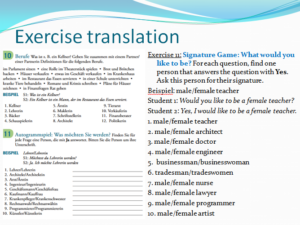Webinar by Vivian Langer (April 2019)
This webinar is meant for second language (L2) instructors who are interested in working against gender inequality and creating an inclusive environment in their classrooms through gender-inclusive language. The webinar explores why it might be benificial to teach gender-inclusive human nouns in L2 classrooms and presents some ideas of how teachers can implement and teach gender-inclusive nouns in their classrooms by using L2 German as an example.
Click here to watch the webinar.
Cite this webinar: Langer, V. (2019, April 29). Second language studies at Vanderbilt: Teaching gender-inclusive language in the second laguage classroom. Retrieved from my.vanderbilt.edu/l2studies/2019/04/teaching-gender-inclusive-language-in-the-second-language-classroom/
Translation of two exercises from the first-year textbook Vorsprung (3rd. edition) used in the webinar:
References:
Cahnmann-Taylor, M., & Coda, J. (2018). Troubling normal in world language education. Critical Inquiry in Language Studies, 1-23. doi:10.1080/15427587.2018.1450632
Ellis, R. (2005). Principles of instructed language learning. Asian EFL Journal, 7 (3), 9-24.
Keysar, B., et al. (June 2012). The foreign-language effect: Thinking in a foreign tongue reduces decision biases. Psychological Science, 23(6), 661-668. doi:10.1177/0956797611432178
Klaus, M. (2016, September 7). Geschlechtergerechte Sprache: Gender Star und Binnen-I. Deutsche Welle. Retrieved from https://www.dw.com/de/geschlechtergerechte-sprache-gender-star-und-binnen-i/a-19516371
Lee, H.-Y. (2014). Inquiry-based teaching in second and foreign language pedagogy. Journal of Language Teaching and Research, 5(6), 1236-1244.
Lovik, T. A. et al. (2017). Vorsprung: A communicative introduction to German language and culture (3rd. ed.). Boston, MA: Heinle, Cengage Lerning.
Vandergriff, I. et al. (Fall 2008). Authentic models and usage norms? Gender marking in first-year textbooks. Die Unterrichtspraxis, 41(2), 144-150.


